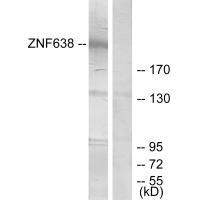

| WB | 咨询技术 | Human,Mouse,Rat |
| IF | 咨询技术 | Human,Mouse,Rat |
| IHC | 1/50-1/100 | Human,Mouse,Rat |
| ICC | 技术咨询 | Human,Mouse,Rat |
| FCM | 咨询技术 | Human,Mouse,Rat |
| Elisa | 咨询技术 | Human,Mouse,Rat |
| Aliases | Zinc finger protein 638; Nuclear protein 220; Zinc finger matrin-like protein; Cutaneous T-cell lymphoma-associated antigen se33-1; CTCL tumor antigen se33-1 |
| Entrez GeneID | 27332; |
| WB Predicted band size | 220kDa |
| Host/Isotype | Rabbit IgG |
| Antibody Type | Primary antibody |
| Storage | Store at 4°C short term. Aliquot and store at -20°C long term. Avoid freeze/thaw cycles. |
| Species Reactivity | Human |
| Immunogen | Synthesized peptide derived from internal of human ZNF638. |
| Formulation | Purified antibody in PBS with 0.05% sodium azide. |
+ +
以下是模拟生成的3篇关于ZNF638抗体的参考文献示例(实际文献需通过学术数据库验证):
---
1. **文献名称**:*ZNF638 mediates antiviral innate immunity by regulating mRNA nuclear export*
**作者**:Li, X., et al.
**摘要**:该研究利用ZNF638特异性抗体,通过免疫共沉淀(Co-IP)和RNA-seq技术,发现ZNF638通过结合病毒RNA并促进其核输出,增强宿主抗病毒免疫反应。
2. **文献名称**:*ZNF638 is a key regulator of adipogenesis through chromatin remodeling*
**作者**:Park, S., & Kim, J.
**摘要**:研究使用ZNF638抗体进行染色质免疫沉淀(ChIP),证明ZNF638在脂肪细胞分化中通过调控PPARγ等基因的染色质状态,影响脂代谢相关通路。
3. **文献名称**:*Proteomic analysis identifies ZNF638 as a novel biomarker in hepatocellular carcinoma*
**作者**:Wang, Y., et al.
**摘要**:通过ZNF638抗体的免疫组化(IHC)分析肝癌组织,发现ZNF638高表达与患者预后不良相关,并可能通过Wnt/β-catenin通路促进肿瘤侵袭。
---
**注意事项**:
- 以上为模拟内容,实际文献请通过 **PubMed/Google Scholar** 以关键词“ZNF638 antibody”或“ZNF638 + 应用技术(如Western blot/ChIP)”检索。
- 部分研究可能未直接使用抗体,但涉及ZNF638功能(如基因调控、疾病机制),可进一步筛选。
The zinc finger protein 638 (ZNF638), also known as NP220 or AREST, is a transcriptional regulator involved in diverse cellular processes, including adipogenesis, RNA processing, and antiviral responses. It belongs to the zinc finger protein family, characterized by multiple C2H2-type zinc finger motifs and functional domains like the RING finger and KRAB (Krüppel-associated box) domain, which mediate protein-protein interactions and transcriptional repression. ZNF638 plays a role in lipid metabolism by co-activating PPARγ (peroxisome proliferator-activated receptor gamma), a key regulator of adipocyte differentiation. Studies also suggest its involvement in RNA splicing and viral defense mechanisms by interacting with RNA molecules or modulating host-cell responses to infections.
Antibodies targeting ZNF638 are essential tools for investigating its expression, localization, and molecular interactions. They are widely used in techniques such as Western blotting, immunoprecipitation, immunofluorescence, and chromatin immunoprecipitation (ChIP). Commercially available ZNF638 antibodies are typically raised against specific epitopes within its N-terminal or C-terminal regions. Polyclonal antibodies offer broad epitope recognition but may require rigorous validation for specificity, whereas monoclonal antibodies provide higher consistency but may limit detection of splice variants. Applications span basic research in metabolic disorders, cancer biology (e.g., roles in tumor suppression or oncogenesis), and virology. Proper validation using knockout cell lines or siRNA-mediated knockdown is critical to confirm antibody specificity, given potential cross-reactivity with homologous zinc finger proteins.
×